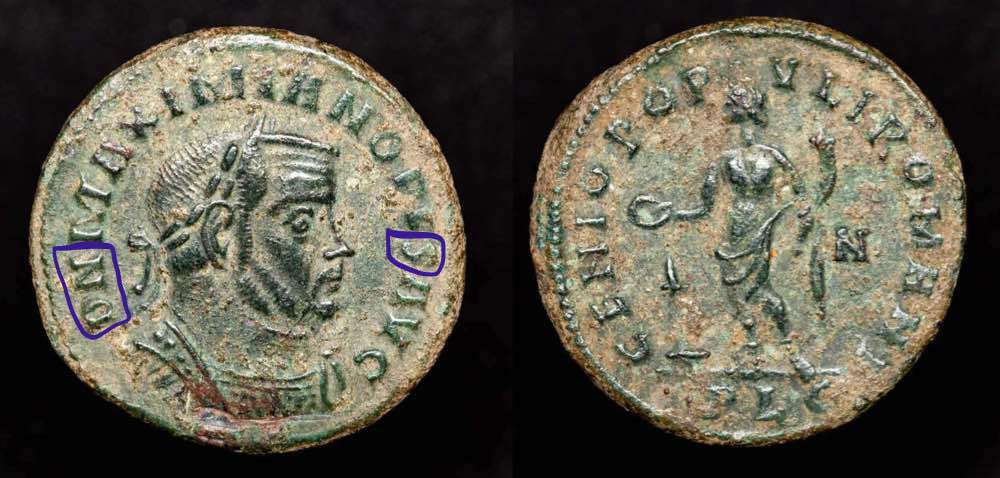 Dominus Noster. DN: A Roman imperial title on Roman coins.
Dominus Noster. DN: A Roman imperial title on Roman coins.
Dominus Noster, abbreviated "DN", "Our Lord" in Latin, is a title commonly used on late Roman coins in the fourth century. "Dominus Noster" is still used today with reference to Jesus Christ. On base-metal (AE) imperial coins "DN" was first used beginning in 305 for Diocletian and Maximian on their retirement issues with the additional new title "Senior Augustus." Senior Augustus means they have years of imperial experience and prestige, but no active military or administrative power.
In late 306 when Maximian began his "second reign" as active Augustus alongide his son Maxentius, "DN" was retained for Maximian at mints of Constantine (Lugdunum, Trier, and London) even though his retirement reverses were discontinued. In 307, when Maximian acknowledged Constantine as co-Augustus, Constantine did the same for Maximian and Maximian's previous "IMP" title was restored and the title "DN" was discontinued for a decade.
Upper right: The first AE type to use "DN" after the retirement issues of Diocletian and Maximian.
Minted by Constantine for Maximian during his second reign, but before Constantine recognized Maximian as an active Augustus.
27-26 mm. 7.98 grams.
DN MAXIMIANO PF S AVG [DN and S for "Senior" circled in purple]
Domino Nostro ... Pio Felici Seniori AVGgusto
"For our lord Maximian, religious/pious and lucky/fortunate senior Augustus"
Struck c. 307 at Lugdunum (Lyons) by Constantine for Maximian (in time interval (3) below).
GENIO POPVLI ROMANI, Genius standing.
altar to left, N in field right, PLC in exergue.
RIC VI Lugdunum 206 "c. Spring 307". This issue includes coins of Constantine and Maximinus II as Caesars and Galerius as Augustus.
For three centuries titles awarded to emperors (other than "Augustus") had been titles from the Roman Republic (PM = Pontifex Maximus, TRP = Tribunicia Potestas, etc.). Coin legends began "IMP" for "Imperator" which was almost synonymous with "Augustus" meaning "emperor." But c. 305 the language on coins began to use some new, more extreme, titles. For example, retirement issues of Diocletian and Maximian have titles such as "FELICISSIMO" (most blessed/happy) and "BAEATISSIMO" (most fortunate) and after a decade some coins replaced the previous "NOB CAES" (noble Caesar) with "NOBILISSIMVS CAES" (most noble Caesar). The new title "DN" had an almost religious connotation; the emperor should be worshipped.
Timeline: This timeline is limited to base-metal Roman imperial coins. The numbers link to images below. (For gold coins and provincial coins, see cursory comments below.)
1) (Without DN) Before May 1, 305 the title DN was not used on coins. The title Imperator, abbreviated IMP, began most legends (coin). (There are very rare Roman coins under Aurelian, Probus, Carus, and Carinus with the title "DEO ET DOMINO" (God and Lord). The idea of a living emperor being a god was in the air.)
2) (With DN on retirement issues) After May 1, 305, when Diocletian and Maximian retired, retirement types were issued for them using the title "DN" which was a new title on coins, and in addition "SEN AVG for "SENiori AVGusto," which was also a new title (coin).
The History: When Diocletian and Maximian retired (May 1, 305) the Caesars Constantius and Galerius became the new Augusti and new Caesars, Severus II and Maximinus II, were appointed. Constantine, son of Constantius, and Maxentius, son of Maximian, were not selected to be the Caesars. After a year, Constantius died at York, Britain, July 26, 306 and Constantine assumed imperial power, acclaimed by the army. Sources say his original title was Augustus, which was reduced to Caesar when Galerius refused to accept the higher title but confirmed the lower one. If this is so, there must have been a time period of weeks for that back-and-forth communication to occur, but coins do not show Constantine minted as Augustus at the beginning of his reign. According to tetrarchal rules, upon the death of Constantius the Caesar Severus II would have become western Augustus, leaving the position of western Caesar open. The coins are evidence that Constantine took the title Caesar and not Augustus at the beginning of his reign in July 306 [contrary to assertions in some history books].
Maxentius usurped power at Rome Oct. 28, 306 and shortly invited his father Maximian to return as Augustus. This begins Maximian's "second reign" and he was recognized as "IMP" (i.e. active emperor) at mints of Maxentius (coin). Retirement issues for Maximian were discontinued while retirement issues for Diocletian continued. For Maximian, Constantine (and only Constantine) continued using "DN" in the legend "DN MAXIMIANO P F S AVG", but with reverses that do not obviously refer to retirement such as GENIO POPVLI ROMANI (the top coin on this page), GENIO POM ROM (coin) and HERCVLI CONSERVATORI (coin). The use of the dative case, "For our lord Maximian," implies Constantine was honoring Maximian, but not subject to Maximian, even though Constantine was merely Caesar.
3) (With DN on post-retirement issues) DN was on non-retirement reverse types for Maximian, only at the mints of Constantine--London, Trier, and Lugdunum--after Maximian began his "second reign," but before Constantine recognized him as an active Augustus. These are the first "DN" AE coins after the initial retirement issues. (The first coin at the top of this page.)
4) (Without DN) When Constantine became Augustus himself and was recognized as Augustus by Maximian, Constantine reciprocally recognized Maximian as active Augustus and switched the legends for Maximian from "DN" to "IMP". Then the use of DN was discontinued until c. 317, see (5) below.
The history: Augustus Severus II tried and failed to retake Rome in spring 307. Then Galerius prepared a second attempt to retake Rome. In March 307 (or later in 307, authors disagree) Maximian went to Constantine to solicit his help and cemented an alliance by giving his daughter Fausta (sister of Maxentius) to Constantine in marriage. Maximian confirmed Constantine had the title Augustus. (Constantine might have assumed that title when the position of Augustus was vacated when Severus II was defeated, or maybe Maximian conferred the title Augustus on him during the visit. However, some authors think Constantine did not mint as Augustus until late in 307.) Constantine's mints switch from having an issue with Constantine as Caesar and Maximian with title "DN ... P F S AVG" (without coins for Maxentius) to having the next issue with Constantine, Maximian, and Maxentius, all as Augusti and all with title IMP. Coins with "DN" were discontinued, except for rare coins from Lugdunum (RIC VI Lugdunum 246ff) with "DD NN" in the reverse legend for Constantine, Maximian, and Galerius as Augusti, all with obverse title IMP.
Maximian returned to Rome. The attempt of Galerius to retake Rome failed in Spring 308. Maximian and Maxentius had a falling out. Maximian fled to Constantine. The mints of Constantine discontinued coins of Maxentius.
5) (With DN under Licinius) DN was not used again until it was revived by Licinius at his mints in 317 when Licinius II (coin), Crispus (coin), and Constantine II (coin) became Caesars. The very rare coins for Martinian in 324 also use DN. DN was discontinued at those mints when they fell to Constantine in 324. The title DOMINORVM NOSTRORVM (genitive plural) is spelled out on some reverses.
6) (With DN after Constantine) Both DN and IMP are used 337-340 after Constantine's death on some uncommon varieties at eastern mints and Rome (but not at western mints) of the extremely common AE4 GLORIA EXERCITVS type. RIC says very few, if any, AE coins were issued 340-346. The pre-reform issues of 347 use DN (coin) or have it on the reverse (coin). The FEL TEMP REPARATIO coin reform of 348 cemented DN as the usual title beginning the obverse legend on coins (coin).
Comments about gold coins. RIC VI Rome 4 is an r5 (unique) gold piece with DN MAXIMIANO CAES attributed to Galerius "c. 294-5" and Rome 13, 15, and 25 are r4, r5, and r5 argentei of Constantius "c. 295-7" with legend DN CONSTANTIO NOB C. Those coin have claims to be the first uses of DN on any imperial coins or medallions because they must be before the retirement issues of Diocletian and Maximian. RIC Rome 137 is an r4 gold piece for Maxentius with DN MAXENTIVS PRINC. Very rare gold pieces from other mints use DN for Constantine beginning c. late 324-326.
1) Before the retirements of Diocletian and Maximian on May 1, 305. The title DN was not used. The title Imperator, abbreviated IMP on coins, was on coins.
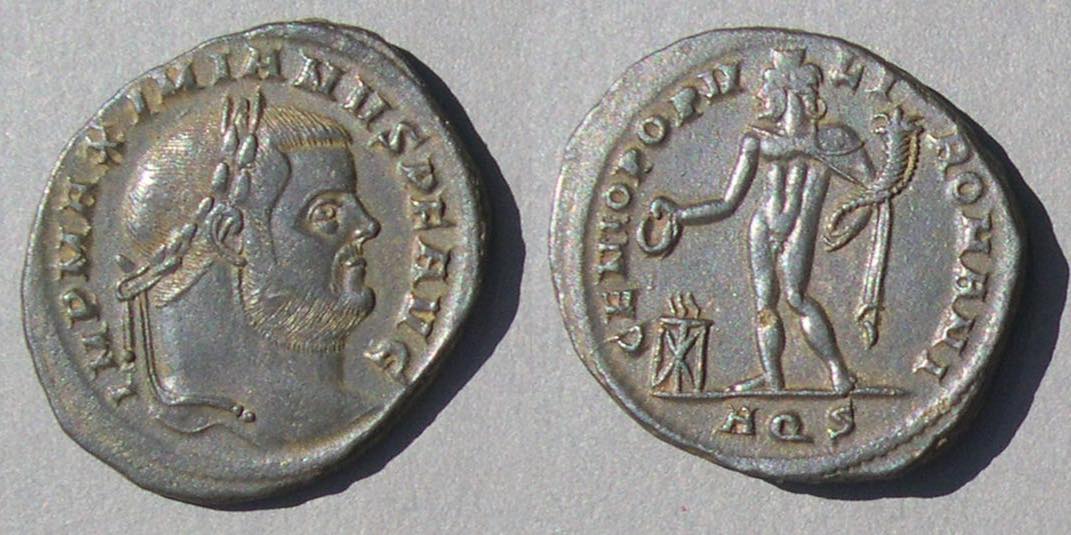 Maximian
Maximian
Aquileia
28-25 mm. 9.11 grams.
IMP MAXIMIANVS PF AVG
altar in field left
AQS in exergue
RIC Aquileia 27b. "c. 299"
2) After May 1, 305, when Diocletian and Maximian retired, their retirement issues styled them "DN," which was a new title, and in addition the new title "SENior AVGustus".
 Maximian, retirement issue
Maximian, retirement issue
27-26 mm. 9.79 grams.
DN MAXIMIANO BAEATISSIMO SEN AVG
PROVIDENTIA DEORVM QVIES AVGG
S F in fields (Saeculi Felicitas?)
PTR in exergue
RIC VI Trier 673b "1 May 305-early 307"
For much more about retirement issues, see the page on retirement issues of Diocletian and Maximian.
3) After Maximian came out of retirement and resumed the title of Augustus under Maxentius in late 306, Maxentius struck coins for Maximian with the restored title IMP.
 Maximian, second reign. Struck by Maxentius, "Autumn 307- c. 309/10."
Maximian, second reign. Struck by Maxentius, "Autumn 307- c. 309/10."
25 mm. 7.35 grams.
IMP C MAXIMIANVS PF AVG
This coin of Maximian has an obverse legend sometimes used by Galerius. The attribution is clear because of the distinctive nose of Maximian and the fact the type was initiated by Maxentius.
CONSERV VRBS SVAE, 6-column temple, Roma within.
RIC VI Aquileia 121b, struck second-reign, "Autumn 307- c. 309/10"
This issue is shared with Maxentius, Maxentius as AVG CONS II, and Constantine as Augustus.
Maximian began his "second reign"when Maxentius invited Maximian out of retirement in late 306. The coin above issued by Maxentius at his mint Aquileia is clearly a second-reign issue because we know Maxentius welcomed him as an Augustus and this type restores the usual titles (IMP and AVG) of an active emperor.
Upon their retirements, Maximian and Diocletian had parallel retirement types. After Maximian came out of retirement, the mints of Constantine as Caesar continued the retirement types continued for Diocletian, but not for Maximian. Constantine minted for Maximian, but not as an active Augustus, rather Constantine minted non-retirement reverse types that used Maximian's retired titles "DN MAXIMIANO P F S AVG." (See the GENIO POPVLI ROMANI coin at the top of this page.) That legend was continued for the subsequent GENIO POP ROM type.
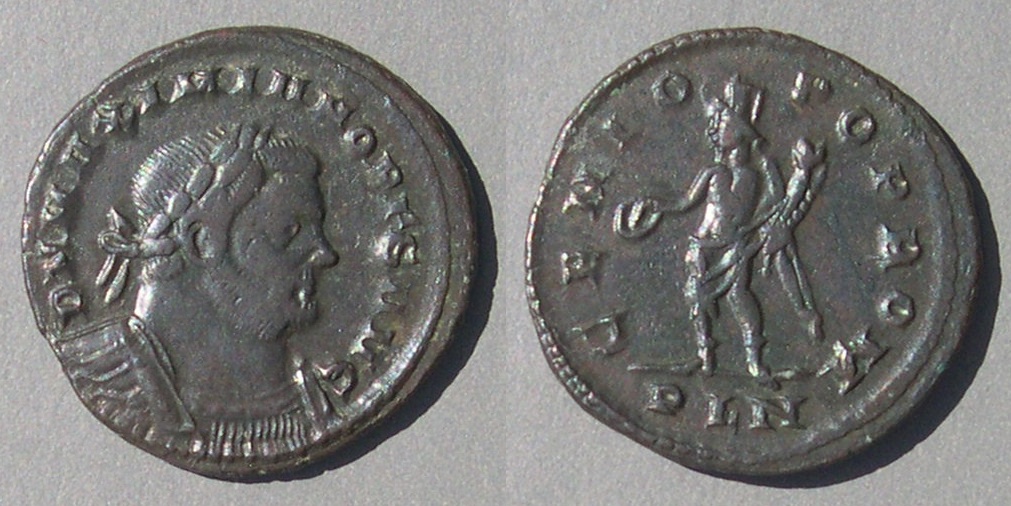
Maximian
25-24 mm. 6.61 grams.
DN MAXIMIANO P F S AVG
GENIO POP ROM
PLN
RIC London 90 "c. summer 307"
This type with Genius and shorter legend was introduced by Constantine as Caesar. Here we see it for Maximian with his retirement titles, but not a retirement reverse type.
This type continued to be issued when he and Constantine recognized each other as Augusti and Maximian's obverse titles changed on coins minted by Constantine from "DN" to "IMP" and "S AVG" to "AVG".
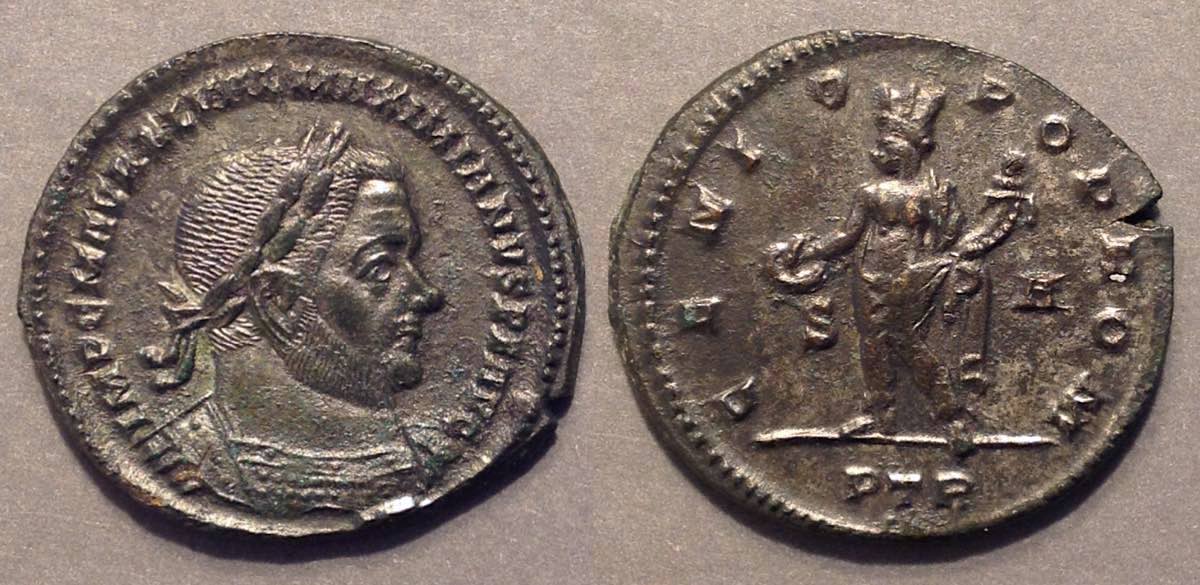 Maximian, recognized as Augustus at a mint of Constantine.
Maximian, recognized as Augustus at a mint of Constantine.
27-25 mm. 7.18 grams.
IMP C M AVREL VAL MAXIMIANVS P F AVG
Note the remarkably long version of his name which makes it clear this is not a coin of Galerius.
GENIO POP ROM
Altar in left field
PLG in exergue
RIC Trier 766 "autumn 307 - end of 308."
In this issue Constantine and Maxentius are also Augusti. Galerius and Maximinus II are omitted.
Next is another type of Maximian issued by Constantine as Caesar.
 Maximian.
Maximian.
26 mm. 7.03 grams.
DN MAXIMIANO P F S AVG
HERCVLI CONSERVATORI
Hercules standing, head left, resting right hand on his vertical club and holding lion skin over his left shoulder.
PLN in exergue.
RIC VI London 91, "c. summer 307"
This issue from London has coins of Constantine as Caesar, Galerius as Augustus, Maximinus II as Caesar, and Diocletian as retired (also with "DN ... S AVG").
In May/June 307 Maximian had the legend DN MAXIMIANO SEN INV AVG on one rare type from Aquileia (RIC Aquileia 106, page 324).
Non-retirement reverse types with the title DN were not issued in this time period other than at mints of Constantine.
4) The next rare coin has Maximian as active Augustus from a mint of Constantine. It is attributed by Zschucke to Trier in summer 307 and the issues of Constantine that he groups with it are of Constantine as Caesar. This does not quite fit the time scheme proposed here. I don't have Constantine minting "IMP" coins for Maximian until he, Constantine, was also Augustus. So, although I would not need to change the "July 25, 307" date, I would group it with coins of Constantine as Augustus that follow that date (rather than precede that date, contra Zschucke).
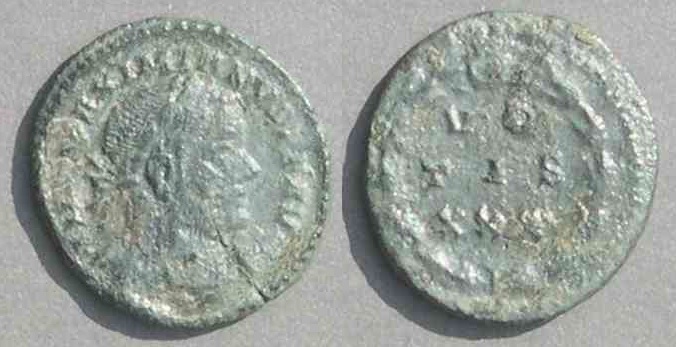 Maximian.
Maximian.
18-17 mm. 1.98 grams. "1/4 follis" (a rare denomination)
IMP MAXIMIANVS PF AVG
Struck summer 307 for his second reign, taking vows for 30 years.
VO/TIS/XXX
RIC VI Trier 754 page 214 "R, c. summer 307"
Zschucke 7.14, page 48. "1/4, by Constantine, for July 25, 307."
The fractional coins of Constantine from this time have Constantine as Caesar.
When Maximian was recognized as Augustus by Constantine, coins minted by Constantine for Maximian have the title "IMP" and omit the title "Senior Augustus" in favor of just "Augustus."
This ends the discussion of the early uses of "DN" on Roman imperial AE coins. You may quit here. This page continues with the later uses of DN and ends with a conclusion and references.
5) The title DN became common on AE coins at mints of Licinius for the Caesars, Licinius II (second next), Crispus (third next), and Constantine II (fourth next), c. 317-324, but the Augusti still used IMP. (Constantine did not use the title DN for himself until c. 324 when it began to be used on gold coins and medallions.) When the eastern mints fell to Constantine in 324, both titles DN and IMP were discontinued on AE in favor of the legends beginning with no title, rather the ruler's name (seventh next). The title DOMINORVM NOSTRORVM is spelled out (in plural) on some reverses (eighth coin down).
The title DN was introduced by Licinius on rare coins from Antioch with Licinius vis-a-vis Licinius II.
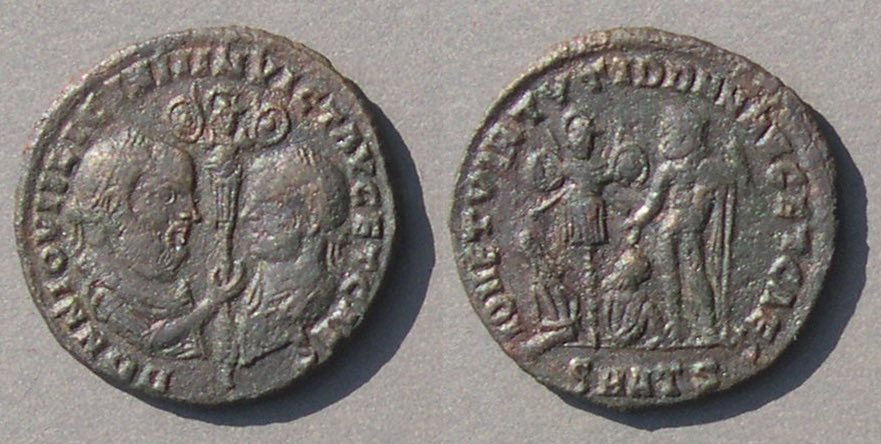 Licinius I and II
Licinius I and II
22 mm. 4.14 grams.
Struck late 317-early 318.
DD NN IOVII LICINII INVICT AVG ET CAES
(Two Ds and two Ns for two emperors.)
Bust facing with trophy between
IOM ET VIRTVTI DD NN AVG ET CAES
Jupiter standing left facing trophy with two captives
SMANTS in exergue
RIC VII Heraclea (in error, it is Antioch) 50. [The attribution was corrected by Bastien in NC 1973, pages 87-97 and plates 5-6.]
The title "DN" was used for each of the three Caesars, but not the Augusti.
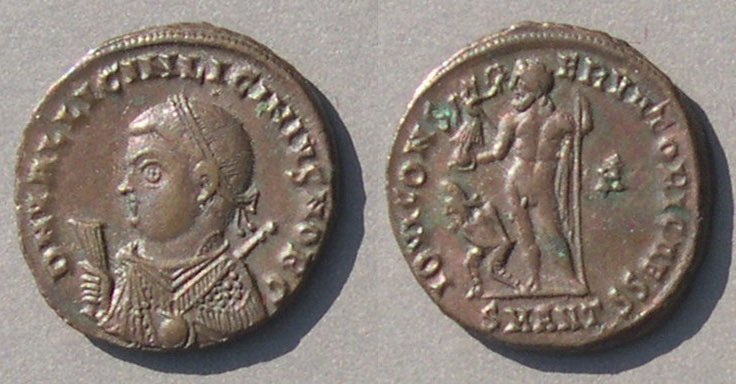 Licinius II, 317-324
Licinius II, 317-324
18 mm.
Struck
DN VAL LICIN LICINIVS NOB C
IOVI CONSERVATORI CAESS
Jupiter standing left holding Victory crowning him, captive to left
H in right field
SMANT in exergue
RIC VII Antioch 29
 Crispus, 317-324
Crispus, 317-324
Struck 317-320
18 mm.
DN FL IVL CRISPVS NOB CAES
PROVIDENTIAE CAESS
Jupiter standing left holding Victory crowning him, palm branch to left, • over A to right
SMN in exergue.
RIC VII Nicomedia 32
 Constantine II, 317-337-340
Constantine II, 317-337-340
20 mm.
Struck 321-324.
DN FL CL CONSTANTINVS NOB C
IOVI CONSERVATORI, Jupiter standing left holding Victory on globe, eagle with wreath in beak to left, captive to right, X/IIΓ (for 12 1/2, a denominational mark) in right field.
SMALA
RIC VII Alexandria 31.
DN was used for the Caesars at Heraclea, Nicomedia, and Antioch until c. 325, but not at Siscia, Thessalonica, Cyzicus, or Alexandria, and not for the Augusti, who were still titled "IMP". It was sometimes used on the reverse at Constantine's mints. The next coin is in the name of Licinius.
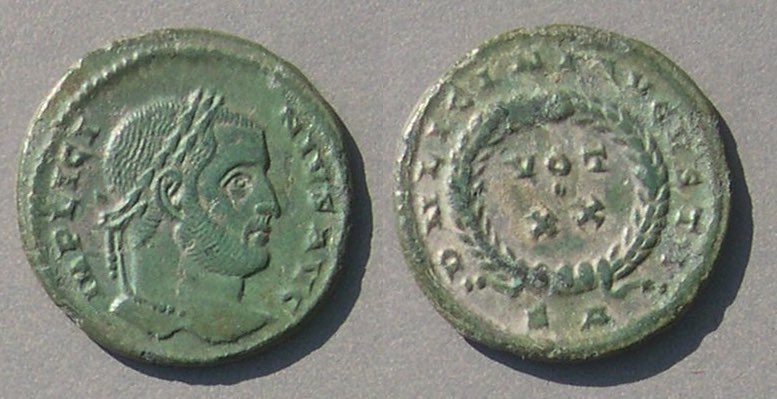 Licinius, 308-324
Licinius, 308-324
19 mm.
Struck 321 at Arles
IMP LICINIVS AVG
DN LICINI AVGVSTI around wreath enclosing
VOT
XX
SA in exergue
RIC VII Arles 229
After the defeat of Licinius in 324 the title DN on the obverse was discontinued in favor of beginning the obverse legend with the emperor's name.
 Constantine II
Constantine II
19 mm.
Struck 324-325 at Sirmium
CONSTANTINVS IVN NOB C
Note the legend does not begin with IMP or DN.
ALAMANIA DEVICTA
• SIRM •
RIC VII Sirmium 50.
Sometimes "DN" appeared on the reverse.
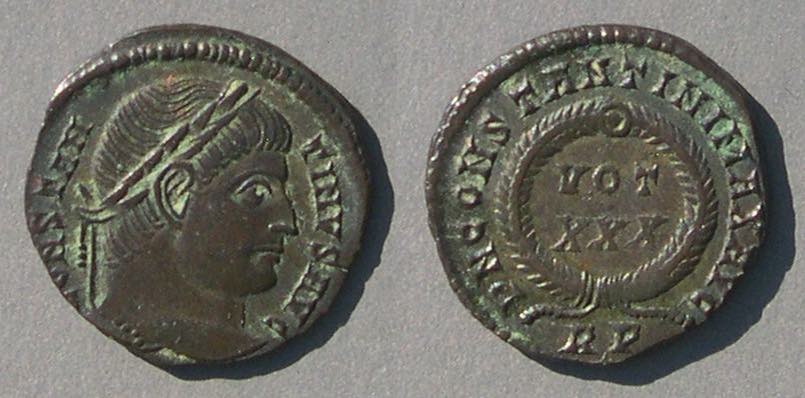 Constantine, 307-337
Constantine, 307-337
19 mm. Struck 329.
CONSTANTINVS AVG
DN CONSTANTINI MAX AVG around wreath with
VOT
XXX
within,
RP below.
RIC VII Rome 318, struck "329"
This use of "DN" around a wreath began as early as 320. There are rare coins from Rome with reverse legend SOLI INVICTO COMITI DN (RIC VII Rome 46-47 and with COM for COMITI, RIC Rome 48, dated to 316).
The title DOMINORVM NOSTRORVM is spelled out (in plural) on some reverses.
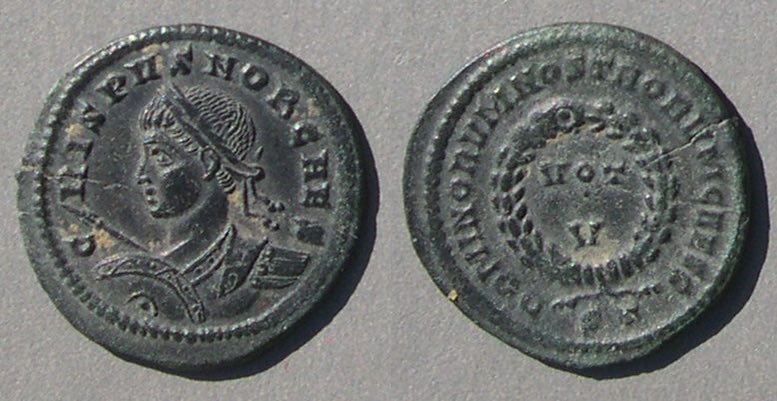 Crispus, Caesar 317-326.
Crispus, Caesar 317-326.
20 mm.
Struck as Caesar 320-321.
Reverse legend: DOMINORVM • NOSTRORVM • CAESS
VOT
V in wreath
A translation is something like "Vows for 5 years of our lords the Caesars".
ST below
RIC Ticinum 150 "320-321"
6) After the death of Constantine in 337 some coins of his sons used DN and other coins used just the ruler's name. Little or no AE was minted after 340 until c. 347 when minting was resumed and DN was on the obverse of some coins and the reverse of others.
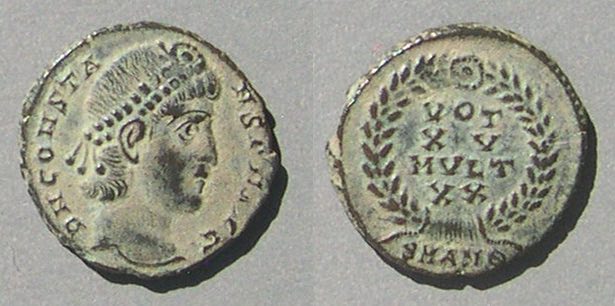 Constans, struck 347-8, according to RIC.
Constans, struck 347-8, according to RIC.
14 mm.
DN CONSTANS PF AVG (Here DN is on the obverse)
VOT/XV/MVLY/XX in wreath
SMANΘ in exergue.
RIC VIII Antioch 116.
 Constantius II, struck 347-8 according to RIC
Constantius II, struck 347-8 according to RIC
CONSTANTIVS PF AVG
VICTORIAE DD AVGG Q NN (Here DN is on the reverse)
(for the two emperors, Constans and Constantius II)
Two victories toward each other holding up wreaths.
SMTSE in exergue.
RIC Thessalonica 99.
By the time of the FEL TEMP REPARATIO coin reform of 348 DN had become the usual title beginning obverse legends on coins.
 Constantius II
Constantius II
25-23 mm.
Struck as part of the coin reform of 348
DN CONSTAN-TIVS PF AVG
FEL TEMP REPARATIO
"Soldier spearing fallen horseman"
ANE in exergue.
RIC VIII Antioch 132.
Many, but not all, coins of Julian II (Caesar 355-360 and Augustus 360-363) begin with DN. Under Jovian (363-364) and all later emperors all obverse coin legends begin with DN.
 Jovian, 363-364
Jovian, 363-364
Large. 29 mm. 8.50 grams.
DN IOVIANVS PF AVG
Laurel and rosette-diademed, draped and cuirassed
VICTORIA ROMANORVM
Emperor standing, head right, holding labarum and being crowned by Victory on a globe.
CONSPΓ in exergue.
RIC Constantinople 176.
Coins of Valentinian, Valens, Gratian, Valentinian II, Theodosius and later emperors all have obverse legends beginning with DN.
Commentary: At the end of the third century Roman imperial coins almost all begin their legends with IMP for "imperator" abbreviated "IMP". During the Republican period and the first century it meant "commander" or "victorious general" and was a title awarded for major victories. During the imperial period it changed to be almost synonymous with "emperor," even if he was young and hadn't had any victories. In the third century it was particular to the emperors and many coins had legends with this format:
IMP <emperor's name> P F AVG
IMPerator Pius Felix Augustus (Pious/religious, Fortunate/happy, emperor)
The title DOMINVS NOSTER, "our lord," was outside the Roman tradition. However, when Diocletian and Maximian retired in 305, even though they were not dead yet, unprecedented retirement issues with the title DN = Dominus Noster were issued for them, which suggests something close to the type of deification which some previous emperors had been awarded, but only after their deaths, with commemorative coins with "DIVO <emperor's name>" on the obverse and "CONSECRATIO" on the reverse. There are very rare Roman coins under Aurelian, Probus, Carus, and Carinus with the title "DEO ET DOMINO" (God and Lord). The idea of a living emperor being a god was in the air.
Provincial coins. The title DN was used on provincial coins as early as under Septimius Severus.
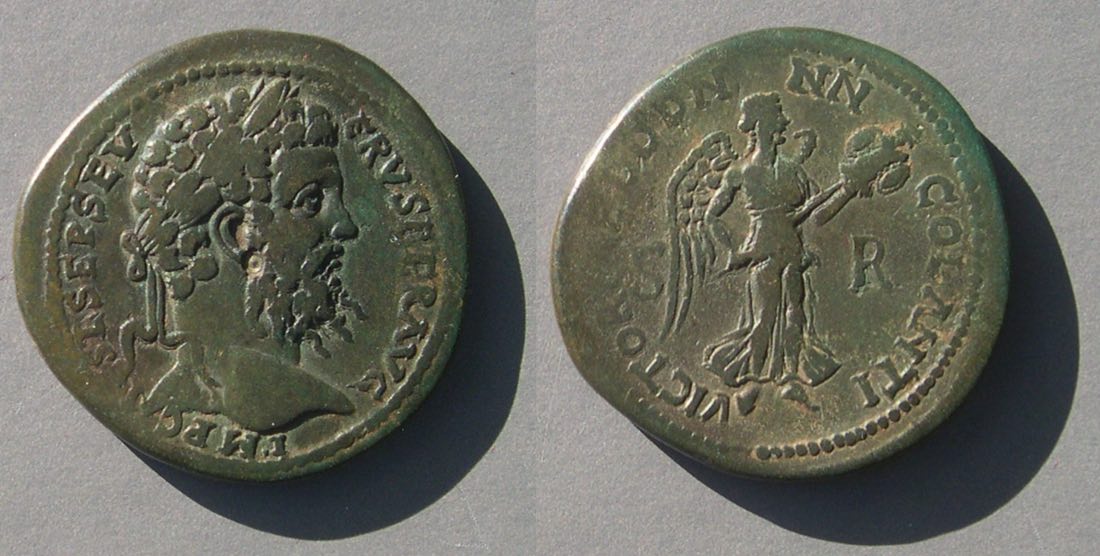 Septimius Severus, 193-211
Septimius Severus, 193-211
34 mm.
Struck at Antioch in Pisidia.
IMP CAES L SEP SEVERVS PER AVG
VICTORIAE DDD NNN COL ANTI
Victory standing right holding trophy forward
S on left, R on right
BMC 23. Weber II Pisidia 3.
Sear Greek Imperial -- .
This triple D refers to the three emperors Septimius Severus, Caracalla, and Geta. Later at this mint DDNN is used for the joint reign of Septimius and Caracalla and then DN for Caracalla alone.
If you know of other provincial coin types or emperors with the title DN, please let me know.  .
.
The title is not just on coins. I know very little about its other appearances, but have been informed there are two milestones from N. Africa and Phrygia, 312-313, that used DDD NNN, referring to Constantine, Licinius and Maximinus just after the Milvian Bridge.
Conclusion. Maximian had been active emperor with coin legends that began "IMP" until Diocletian and Maximian retired May 1, 305 Retirement issues for them used the new titles "Dominus Noster" and "Senior Augustus" and with legends of the form "DN .... SEN AVG". When Maximian came out of retirement in late 306 at the invitation of Maxentius his title IMP was restored at mints of Maxentius, but coins issued by Constantine for Maximian retain his "DN MAXIMIANO P F S AVG" legend. These are the first uses of DN on AE coins other than the retirement coins of Diocletian and Maximian. Later, after Maximian confirmed Constantine as Augustus, mints of Constantine use title IMP for Maximian. The title "DN" then is not used for a decade.
In 317 when the sons of Licinius and Constantine were made Caesars, mints of Licinius used the title DN for them (but not on obverses for Licinius and Constantine). From 317 to 324 both IMP and DN are in some obverse legends. Then neither is used on AE until 337--instead, the emperor's name begins the legend. However, by the time of the coin reform of 348 DN usually begins the legends. Not all coins of Julian II (355-360-363) begin with DN, but under Jovian (363-364) and all later emperors they all do. The concept of the emperor as "Our Lord" has taken over.
References:
RIC (Roman Imperial Coinage) VI, by Sutherland, 1973.
RIC VII, by Bruun, 1966.
RIC VIII, by J. P. C. Kent, 1981.
Sincere thanks to Peter Christenson and Myrian Merola for their helpful information about Latin and the history of these issues. However, I alone am responsible for my opinions about how dates and political events are reflected by the coins.
Return to a page listing and linking to pages on coins of the tetrarchies.
Return to the main Table of Contents page of the entire educational site.
 Dominus Noster. DN: A Roman imperial title on Roman coins.
Dominus Noster. DN: A Roman imperial title on Roman coins. Maximian
Maximian
 Maximian, second reign. Struck by Maxentius, "Autumn 307- c. 309/10."
Maximian, second reign. Struck by Maxentius, "Autumn 307- c. 309/10."
 Maximian, recognized as Augustus at a mint of Constantine.
Maximian, recognized as Augustus at a mint of Constantine.






 Constans, struck 347-8, according to RIC.
Constans, struck 347-8, according to RIC. Constantius II, struck 347-8 according to RIC
Constantius II, struck 347-8 according to RIC Constantius II
Constantius II Jovian, 363-364
Jovian, 363-364 Septimius Severus, 193-211
Septimius Severus, 193-211 .
.